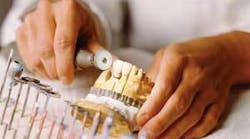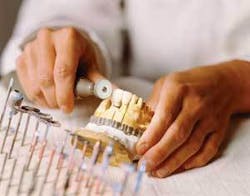Aninterviewof Dr. Gordon Christensen and Dr. William Yancey by Dr. Joe Blaes
The dental laboratory industry is experiencing some very difficult challenges to the traditional systems that have existed for years. These challenges prompted Dr. Gordon Christensen and Dr. William Yancey to convene a lab summit conference in February 2005 and 2006. The conference brought together the many factions comprising the laboratory industry, including suppliers, manufacturers, educators, and practicing dentists. I was fortunate to attend both of these meetings. It is my hope that the following interview with Dr. Christensen and Dr. Yancey will help you understand some of the underlying causes of the problems facing the dental industry as a whole. - Dr. Joe Blaes
Dr. Blaes: From my experience, I would say that most dentists do not realize there is a dental laboratory crisis. Can you give our readers an overview?
Drs. Christensen and Yancey: The dental laboratory crisis has been developing for many years, as lab schools have continued to close, and young persons have not elected to go into laboratory technology. The major issues that we identified in our workshop last year were:
1) Dental technician education is becoming unavail-able in the United States
2) Certification for technicians has not been an importantt or required action for technicians
3) The continuing expansion of offshore laboratories has made unfair competition with American labs
4) There is a genuine lack of interaction of American dental technicians and dentists.
Dr. Blaes: How did we get into this predicament and how does it affect my practice?
Drs. Christensen and Yancey: Dental technology is a major portion of American dentistry, especially now that esthetic procedures are accomplished so often. It is estimated that one-third of the laboratory industry’s income in America is produced from ceramic veneers alone.
If the laboratory education problem continues, the only remaining way for a person to get into technology in the U.S. will be on-the-job-training. Certification for technicians needs to be emphasized to provide higher status, better salaries, and knowledge of qualifications for technicians and the dentists and patients they serve.
The offshore problem is acute. Laboratory work is being done in numerous countries at a fraction of the cost in the United States. The result is that the American technician either cuts costs to the bone, lowers quality, or hires less-costly employees to compete. Additionally, dentists do not know the location of the fabrication of their prostheses, their content, or the infection-control standards used in its fabrication. It has been estimated that if some control is not effected soon on this problem, many American laboratories will be forced to close or use offshore workers. The same phenomenon has been observed when Wal-Mart comes into small towns. Many of the small business owners are forced to close.
The increase in offshore work decreases the dentist-technician interaction - which is the opposite of the needed change toward increased interaction. Both the distance involved and the language barriers will impede the interaction.
Dr. Blaes: OK, I’m convinced. What difference does it make if my case goes out of the country?
Drs. Christensen and Yancey: You do not know the location of fabrication, the metals, plastics, or other materials used in the prostheses. If you want to have any customization, it is difficult or nearly impossible. These challenges can be overcome; but to overcome them requires administrative leadership that we have yet to see from our national dental and laboratory organizations.
Dr. Blaes: Are they using substandard materials or processes in these labs outside the U.S.?
Drs. Christensen and Yancey: Very candidly, we don’t know what is being used. The FDA or other organizations should be evaluating these restorations but, to date, that concept seems to have escaped enforcement. Some of the offshore work is supervised by American labs, and the components of the work and the quality is checked. Some of the crowns coming from off shore look pretty good, but others are not up to American standards.
Dr. Blaes: How do I know where my case is being processed?
Drs. Christensen and Yancey: You don’t know where your case is being made unless you force the American contact or the foreign owner to tell you. It is suspected that many dentists using offshore work do not know that it is being made off shore. Quite obviously, a local lab can contract with a foreign lab to have cases done at a significantly lower cost than they can be made in the U.S. Therefore, the profit margin for the American lab is higher than if higher-paid American technicians made the prostheses.
Dr. Blaes: I can remember when most lab techs were CDTs. What happened to the schools and interest in being certified?
Drs. Christensen and Yancey: Each year, more and more laboratory schools in the U.S. are closing. Fewer technicians are being educated. Many laboratory technicians do not seem to care if they have the CDT designation or not. Only a couple of states require a dental laboratory technician to have the CDT qualification. We should lobby states to increase that qualification standard.
Dr. Blaes: Laboratories seem to be leaning to milling machines as an answer to their problems. In your opinions, is this the answer?
Drs. Christensen and Yancey: Although milling of all-ceramic or metal alloy frameworks and prostheses is increasing, there is still the need for significant human involvement, especially in the more complex cases. However, it is clear that computer-driven milling of prostheses will be a major portion of the laboratory industry in the not-too-distant future.
Dr. Blaes: Since the number of schools has been reduced, how are the dental labs finding employees? Who trains them?
Drs. Christensen and Yancey: Large laboratories have training programs to educate their technicians. Smaller labs are training on the job. This must be changed for the good of the dental profession at large. Standardization of teaching and certification is a must for the future.
Dr. Blaes: Do you see an increase in dental lab fees? How will this affect my bottom line?
Drs. Christensen and Yancey: To date, the foreign lab work has not caused an increase in laboratory costs, because it has mainly catered to the low- to medium-cost lab work. The boutique labs in America are already at a very high cost when compared to the normal lab fee for typical dentistry, and the higher cost does not necessarily mean higher-quality lab work. I don’t see the average lab cost going up. In fact, in recent times, the lab fees for the typical day-to-day crown has stabilized.
Dr. Blaes: Will the number of small labs decrease and the big labs get bigger? How will this affect the average dentist?
Drs. Christensen and Yancey: Nobody knows the answer to this question, but it is estimated that the larger labs will indeed get larger, and that the small- to medium-size labs (which now make up the majority) will wither and die. The small boutique labs will probably remain.
Dr. Blaes: With all the hype about “extreme makeovers,” more patients are requesting more esthetic crown and bridge procedures. How does this lab crisis affect our ability to do this?
Drs. Christensen and Yancey: This is a very delicate subject. The overtreatment with veneers, crowns, and other oral treatment is appalling. To date, young and older dentists are seeking out locations to learn about many of the “esthetic” procedures. Unfortunately, some of those locations are less than ethical in their overtreatment approaches.
Dental schools and graduate programs, especially in prosthodontics, must take a leadership role in education of the profession - both dentists and technicians - in ethical, honest esthetic procedures. The need can be met, but immediate revision of dental and laboratory education is mandatory.
Dr. Blaes: If I prescribe a certain metal, porcelain, pressed ceramic, or zirconium, how do I know that the requested material was indeed used on the case?
Drs. Christensen and Yancey: This is an honesty challenge. If dentists and technicians are honest and disclose the constituents of the prostheses they make, the challenge is met. As in any other area of life, honesty is desired but not always delivered.
Dr. Blaes: Will the labs continue to stand behind their products?
Drs. Christensen and Yancey: Yes, laboratories or any other business or professional activity must stand behind their services, or they will soon be out of business.
Dr. Blaes: Dental laboratories routinely have problems with preparations that do not remove enough tooth structure. How can we teach the dentists?
Drs. Christensen and Yancey: This is a dental school education problem. Fixed prosthodontics comprise about one-third of the income of a typical general dentist. Schools need to wake up to the dire need to educate the neophyte dentist to be able to prepare teeth adequately for optimum laboratory work to be accomplished. There are many needed changes in dental education, and this is certainly one of the most pertinent ones.
Dr. Blaes: Dental laboratories routinely have problems with the impressions that dentists send to them. How do we train the dentist in proper impression techniques? How do we train their auxiliaries since more and more states are allowing them to take final impressions? Maybe they will do a better job?
Drs. Christensen and Yancey: Impressions are done improperly much of the time, and that has been the case for many years. Again, dental education must take the responsibility to remedy this problem.
In summary, there is not only a dental laboratory crisis; there is a crisis in dental education. There is far too much to teach budding dentists in our current three- or four-year curriculum. When they graduate from dental school, they have only the bare rudiments of dental practice. Years are required for a new dentist to become competent. Additionally, many new dentists have almost no technical knowledge, and they must depend on the dental technician to know the technical aspects of the procedures.
A major revision of dental and dental technology education is in order! Interaction between dentists and technicians is needed, and must be enacted. In the past, dental school and technical school interaction was present and it needs to be started again. Better and more technician education and required certification must be instituted immediately. The status and income of technicians must be raised.
In short, dentists and technicians are a team. You can’t play football with 10 players on the team. Similarly, you can’t practice dentistry with the lack of teamwork and leadership abounding today.
Let’s get organized and do it!
Dr. Gordon Christensen is a practicing prosthodontist in Provo, Utah. He is the founder and director of Practical Clinical Courses, and co-founder and senior consultant of Clinical Research Associates. He is an adjunct professor at Brigham Young University and the University of Utah. He may be reached by calling (800) 223-6569 or (801) 226-6569.
Dr. William Yancey is the Assistant Dean and Director of UCLA Continuing Dental Education. He may be reached by calling (310) 206-7557.







